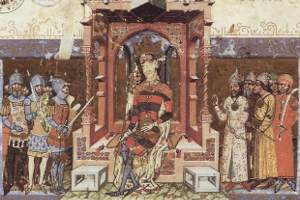Selected illustration from the
Chronica de Gestis Hungarorum of Mark Kálti
Képes Krónika, Hungary, c.1360

The Frontispiece of the Képes Krónika, Hungary, 1360
Országos Széchényi Könyvtár, Budapest
Source

Referenced on pp.322-323, Arms and Armour of the Crusading Era, 1050-1350, Western Europe and the Crusader States by David Nicolle.
888 Hungarian National Chronicle, Hungary, c.1360
(National Széchényi Library, Ms. Clmae 404, Budapest, Hungary)
A-B - Subjects of King Louis I f.1; C-E - Huns arrive in Pannonia, f.4a; F - Mongols defeat King Bela, f.63b; G-I - Ladislas and the Cuman abductor, f.36a; J - Kund, the fourth Magyar champion, f.13a; K - Another Magyar champion, f.13a; L - Arpad and the champions of the Magyar Conquest, f.12a; M - Carol Robert, Governor of Bessarabia-Moldavia; N - King Stephen; O - Battle of Rozgony; P - Hungarians oppose the Crusaders of Conrad III and Louis VII; Q - Axe of Prince Geza; R-S - Arpad arrives in Pannonia, f.11. The Hungarian National Chronicle, though painted in a very Italian style, is an invaluable source for the arms and armour of 14th century Hungary, including various subject and tributary regions. The eastern origins of the Magyar people are emphasised by giving some of the figures slightly oriental or Byzantine military equipment. Basically, however, the Hungarians are shown in typical mid-14th century arms and armour. This normally includes a bascinet and mail aventail (A, G, I, L and S), once also shown with a large visor (O). Variations include decorations and crests (A) or a hat worn over the bascinet (S). A long-sleeved mail hauberk is generally worn with gauntlets, under a coat-of-plates (A, G, I, J, L-O, R and S). Many figures also wear full Western European leg-harness of mail chausses and plate cuisses, poleyns, greaves and sabatons (A, I, M, O and S). One figure (N) appears to have laminated sabatons and some other form of chausses which are shown in a different colour. He also has a different surface texture to his mail hauberk. Also note that the horizontal lines on this man’s surcoat are heraldic and are not concerned with the structure of his coat-of-plates. Another typically mid-14th century Western feature are the roughly square shields with lance rests in the top corner (A, G, K, L, N, O and S). These are not only carried by men in typically Western armour, but also by others (K). Most swords are characteristically straight, tapering, long-hilted and long-quilloned European weapons (A, J, K, L-N and S). Spears are similarly unremarkable, while daggers are notably absent. A large, long-hafted axe (Q) is probably more symbolic than real, but reflects the guisarmes of the 13th century. Non-Western features include curved sabres which are specifically associated with people of Turkic origin, either the Kipchak-Kun subjects of Louis the Great (B) or the Mongols who defeat King Bela (F). Horse-archery and recurved composite bows are also associated with such peoples, but not invariably so (B, G and P). The artist seems to make it clear that horse-archers were regarded as a normal part of the Hungarian army. People whose culture was still within that of the Eurasian steppe tradition, whether they are enemies or allies of the Hungarians, are distinguished by such costume features as ankle-length double-breasted coats (B, F, I and J), abundantly long sleeves (R), and various pointed, fur, upturned, brimmed and otherwise exotic hats (B, F, G, H, J, K, R and S). The central chest medallion, which remains a largely unexplained feature, seems to have been adopted from the Mongols, amongst whom it might have had an heraldic function (B, K, R and S). It was similarly adopted in many regions of the Islamic world in the post-Mongol period. The unusual or non-Western European armour may shed light on some of the fringes of the Hungarian state, particularly those in the Byzantine-influenced east and south. These variations include helmet crests (A), pointed helmets of Asiatic form (E), helmets with aventails that hang like curtains on the sides and back of the head rather than also covering the wearer’s throat (E and L), chapel-de-fer war-hats (E) and other helmets with broad rims (D, J and L). The presence of splinted arm protections hanging from shoulder roundels or epaulettes is a bit of a problem (A, E, R and S). Some examples might be unrealistic Byzantine archaism, but here they are worn by the contemporary Hungarian nobility (A), by ‘Huns’ (E), perhaps by Arpad the Conqueror himself (R), and by his early Magyar followers (S). Perhaps such pieces of military costume survived in the Balkans even into the 14th century as marks of rank or status. As such they would have continued the old Byzantine tradition of coloured pteruges as military identification marks. A number of men carry large oval shields (A, E and J). Although these are also seen in Italy and elsewhere, their presence in Hungary, where they are carried by a fully armoured elite, may similarly set this area slightly apart from most of its Western neighbours.